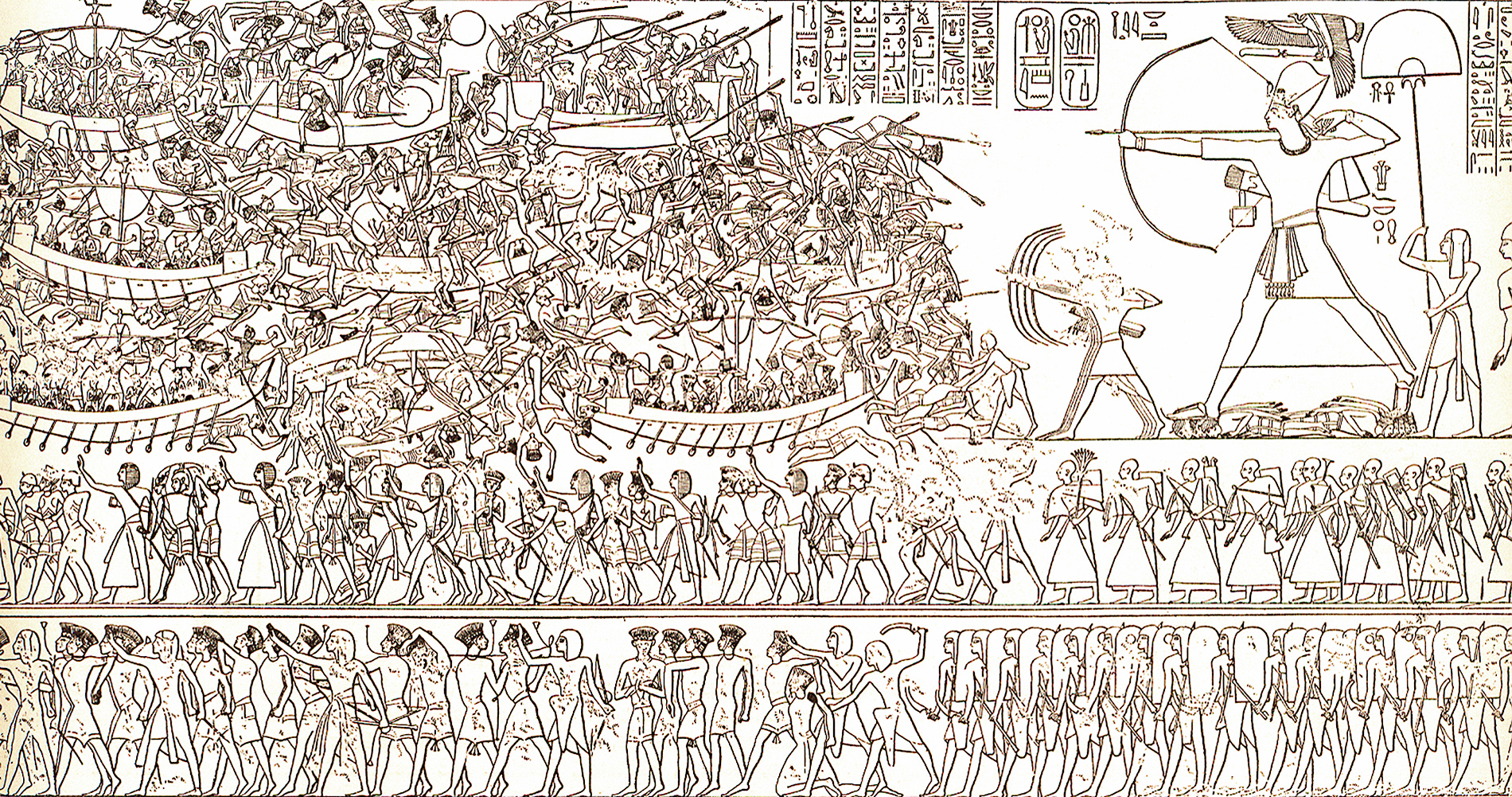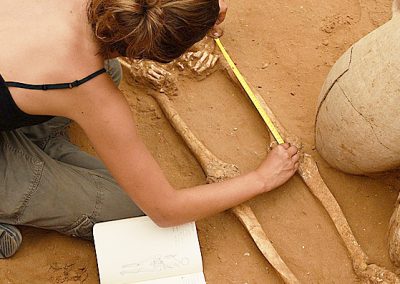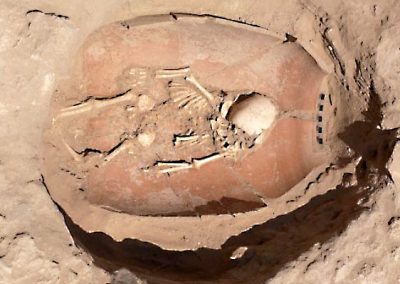
Bible, History, Archaeology
Bible,
History,
Archaeology
A Philistine cemetery
Introduction
For several decades, archaeological missions have followed one another in the hope of uncovering a major Philistine cemetery. This has now been achieved, with the discovery of almost 200 bodies, paving the way for a vast anthropological study of this people who have disappeared from history.
An astonishing discovery
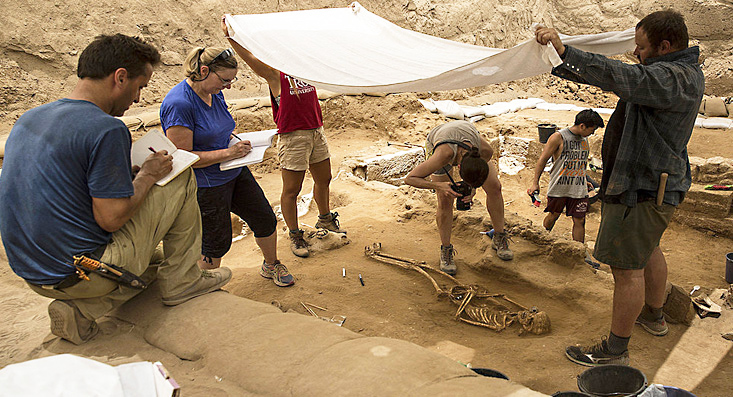
The burial site discovered appears to be the first major cemetery of this mysterious population, which disappeared around 3,000 years ago. Radiocarbon dating and ceramic analysis indicate that it was used between the end of the 11th century and the beginning of the 8th century BC.
Images opposite: a survey with drawings and photographs of a skeleton unearthed at the Philistine burial site at Askalon © Tsafrir Abayov for The Leon Levy Expedition to Ashkelon.
Other sites containing artifacts identified as Philistine, as well as a funerary site of lesser importance, were discovered in the 1950s in the ancient city of Yavneh (probably Jamnia) dating from the same period, and yet another site in the ancient city of Azor near present-day Tel Aviv.
The first burial pits of the ancient Philistine port city of Askalon were unearthed in 2013. With a population of thirteen thousand at its peak, the ancient city, now buried beneath a public garden, is gradually being revealed through excavations.
The excavations have been kept secret for around three years, for fear of the reaction of ultra-Orthodox Jews who fear the desecration of Jewish graves. The pits will soon be completely filled in.
A few dozen metres from the pits, an open-air laboratory has been set up by the archaeological mission. Sherry Fox, an archaeoanthropologist specializing in the analysis of remains, is in charge of making the bones «talk».
Daniel Master, professor at Wheaton College in Illinois and co-director of the Askalon dig, is taking part in the excavations under the responsibility of the Israel Antiquities Authority. For him, the dig is the culmination of many years of research, and an opportunity to come into real contact with the Philistines. The nearly 200 bodies discovered should provide a better understanding of their funeral rites and way of life.
The traces visible on the skeletons clearly show that their living conditions were harsh. Some of the bones show signs of stunted growth, probably due to poor diet or childhood illness. Their bones also show that their work was very physical and that they practiced consanguinity. Archaeoanthropologists believe, however, that they were of normal height, and that no «giants» modelled on Goliath have been found on the site.
Excavations kept secret for three years

Image opposite: Archaeologist Sherry Fox «cleansing» a skeleton at the Philistine burial site at Askhelon. Menahem Kahana - AFP.
The traces visible on the skeletons, she explains, show that their living conditions were harsh. There are signs of stunted growth, probably due to hunger or childhood illness. We can also see from their bones that their work was very physical, that they practiced inbreeding and that they used their teeth as tools, probably for weaving. Sherry Fox believes, however, that their appearance was not repulsive, that their size was normal and that no Goliath-like «giants» have been found. As for their relations with the other inhabitants of the Levant, Daniel Master is adamant that their languages had some points in common.
 Image opposite: an exhumed skull from the Philistine burial site. Tsafrir Abayov for the Leon Levy Expedition to Ashkelon.
Image opposite: an exhumed skull from the Philistine burial site. Tsafrir Abayov for the Leon Levy Expedition to Ashkelon.
The city of Ashkelon was completely destroyed by Nebuchadnezzar in December 604 BC, and the survivors exiled to Babylon. The subsequent occupants were very different from the Philistines.
Excavations at the Ashkelon cemetery have been kept secret for three years, for fear of the reaction of ultra-Orthodox Jews who fear the desecration of Jewish graves. The Philistine graves will soon be completely filled in. A few artifacts will nevertheless be on display at the Rockefeller Museum of History and Archaeology in Jerusalem from July 10, 2016.
The Philistines, a people deprived of history
Who were the Philistines?
They are certainly part of the «Sea Peoples» whose invasion of Egypt was repulsed by the pharaohs Merenptah, around 1210 BC (Che «Peoples of the Sea» are mentioned on the Merenptah stele in the Egyptian Museum in Cairo, and originally came from the temple of Amenhotep III.) and Ramses III in around 1194 B.C. (The episode is engraved on the outer walls of his temple at Medinet Habou, Egypt.) destabilized the entire Near East in the 13th / 12th century B.C. at a time when cities and civilizations in Greece and the Middle East were collapsing.
Image opposite: archaeologist Kathryn Marklein cleans bones unearthed at the site. Tsafrir Abayov for the Leon Levy Expedition to Ashkelon.
Much of what we know about the Philistines comes from Egyptian and Assyrian texts, as well as texts in the Old Testament (Jeremiah 47:4, etc.).
For some historians, however, their origin remains uncertain and debated to this day. Did they come from the region of Mycenae, as suggested by their red and black pottery, and their equipment described in detail at the temple of Medinet Habou, or did they come from Caphtor, which would be Crete (Caphtor in Hebrew), or perhaps from Cappadocia (Amos 9:7)?
The only certainty is that they were foreigners to this region populated by Semites (Canaanites, Israelites, etc.). Their presence is archaeologically attested between 1200 and 600 B.C., on a narrow coastal strip from present-day Gaza to the height of Gézer. When they settled on the eastern Mediterranean coast, the Philistines divided themselves into five small fortified principalities. These kings formed a coalition in which they were all equal. Each kept control of his own city, as can be seen in the relationship between Achish, king of Gath, and David, future king of Israel (1 Samuel 27:5-7), but they collaborated in times of national emergency (Judges 16:5).
The Philistines, proud traders and seafarers, spoke an Indo-European language, did not practice circumcision and ate pork and dog, as evidenced by the bones found in the ruins of four other neighboring Philistine cities: Gath, Gaza, Ashdod and Ekron.
When the Philistines arrived in the Levant, they came up against the Israelite tribes in the hinterland and engaged in a merciless struggle with them. The Philistines combined their forces in concerted action, making them formidable, especially as they possessed heavy armaments and professional armies. This people, relatively few in number compared with the other nations of the region, owed their supremacy to the fact that they were the only ones to know the secrets of making tools and weapons from iron, (I Samuel 13:19) superior to the bronze used by the Israelites.
In later history, Philistine cities are found in the archives of Neo-Assyrian and then Neo-Babylonian kings, as their reigns change.
We know that in 806 BC, the Assyrian Adad Nerari III reconquered the Mediterranean countries, including Philistia, followed by Teglath Phalazar III from 734 to 732. The latter waged wars of conquest, occupying territories divided into provinces with permanent garrisons and couriers to report revolts. He deported large numbers of people. On the death of Sargon II, there was a general uprising throughout the Levant. His son Sennacherib defeated the Philistine coalition at Elteqeh. The king of Ashdod is handed over to the Assyrians.
Nebuchadnezzar II (the Nebuchadnezzar of the Bible), king of Babylon, defeated the Egyptians at Karkemish and conquered the entire Levant. In 604, Askalon was sacked, its king taken prisoner and its population deported.
From that point on, we have virtually no trace of the Philistines. They were assimilated into the Canaanite culture and eventually disappeared from the biblical text and history in general, leaving behind the name of Palestine (Palaestina) that the Romans attributed to this region during Hadrian's reign in 135 CE.
Fresco engraved on one of the walls of the temple of Ramses III at Medinet Habou.
Philistine prisoners taken captive by the Egyptian army. © Theo Truschel.
How do we know them?
The history of the Philistines is best known through the image left of them in the Bible by their enemies and neighbors, the Israelites. The Philistines are mentioned in the Book of Judges, with their battles against Samson, in the Book of Samuel, which recounts the capture of the’Ark of the Covenant by the Philistines at Apher and the famous duel between David and the giant Goliath.
Image opposite: «Cleaning» of a skeleton buried with a terracotta perfume vial now welded to its skull © Tsafrir Abayov for the Leon Levy Expedition to Ashkelon.
In the course of history, Philistine cities are found in the archives of Assyrian kings, then Babylonian kings, as their reigns change.
We know that in 806 the Assyrian Adad Nirari reconquered the Mediterranean countries, including Philistia. Tiglath Pileser III from 734 to 732. He waged wars of conquest, occupying territories divided into provinces with permanent garrisons and couriers to report revolts. He deported large numbers of people. On the death of Sargon II a general uprising took place throughout Palestine. At Elteqeh, Sennacherib, his son, defeats the coalition to which the Philistines belonged. The king of Ashdod is handed over to the Assyrians.
Nebuchadnezzar (the Nebuchadnezzar of the Bible) king of Babylon was victorious over the Egyptians at Karkemish and took over the whole of Palestine. In 604, Ashkelon was sacked, its king taken prisoner and its population deported.
Since then, we've had virtually no Philistine history.
 Recent discoveries
Recent discoveries
(Live Science 07/2019)
After analyzing the DNA of ten ancient individuals buried on one of the Philistine archaeological sites, an international team of researchers has discovered that the Philistines were probably descended from peoples of Greece, Sardinia or even Iberia (today's Spain and Portugal). These ancestors migrated across the Mediterranean in the late Bronze or early Iron Age, over 3,000 years ago.
Image opposite: American archaeology students unearth a skeleton during excavation work at the Philistine cemetery in Ashkelon National Park. REUTERS / Amir Cohen.
But this European genetic signal was short-lived. Once the Philistines arrived in the southern Levant, on the eastern Mediterranean coast, they intermarried with the local inhabitants and, within a few centuries, this genetic imprint introduced in the early Iron Age was no longer detectable and seems to have diluted into a local gene pool linked to the Levant.
The famous image of the naval battle, engraved on the walls of the Medinet Habou temple. Photo © Théo Truschel.
The panel measures approximately 6 x 12 m. We can distinguish several specific groups of enemy fighters, whose inscriptions are given as the distinguishing marks of a particular people; the Peleset whose name survives in the term Palestine, the Shekeles and Thekker with their very curious feathered helmets, as well as other representatives of the Sea Peoples. The Egyptians shoot at their enemies. They board the ships: one is about to sink; in another, the sailors surrender. The survivors are welcomed aboard ship and on shore, where they are lined up in long lines of prisoners. Pharaoh, standing over the heads of the defeated enemies, dominates the struggle with a martial air.
Harvard University archaeologist Lawrence E. Stager at the site of the first Philistine cemetery ever found in Ashkelon. © AFP.
Harvard University archaeologist Lawrence E. Stager at the site of the first Philistine cemetery.
Skeletal measurements. Tsafrir Abayov for the Leon Levy Expedition to Ashkelon.
Skeletal measurements.
Skeletal measurements. Tsafrir Abayov for the Leon Levy Expedition to Ashkelon.
Skeletal measurements.

 Image opposite: an exhumed skull from the Philistine burial site. Tsafrir Abayov for the Leon Levy Expedition to Ashkelon.
Image opposite: an exhumed skull from the Philistine burial site. Tsafrir Abayov for the Leon Levy Expedition to Ashkelon.

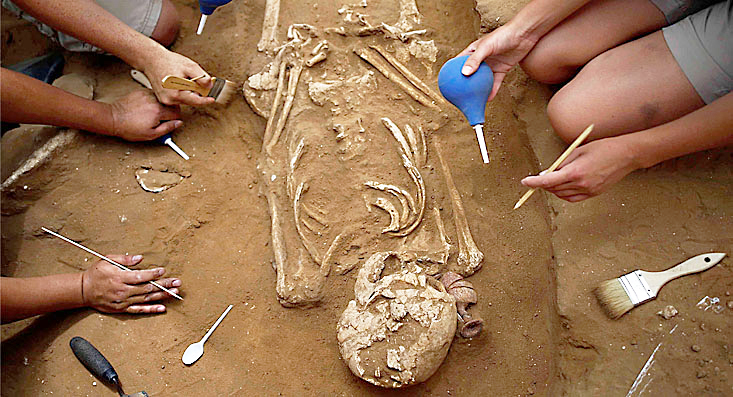 Recent discoveries
Recent discoveries 